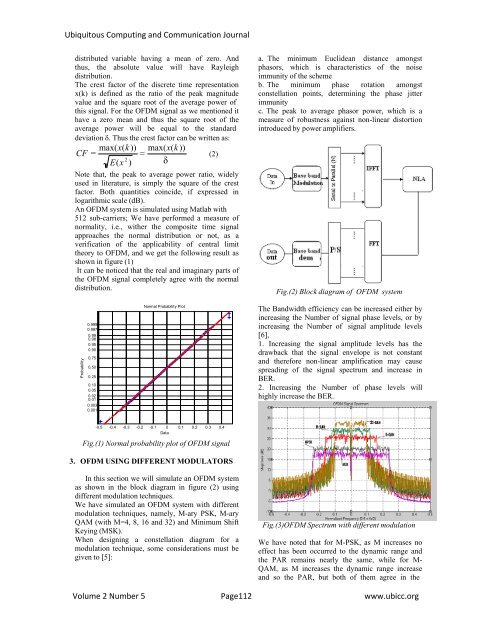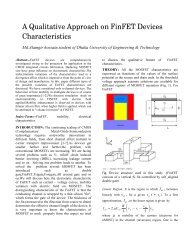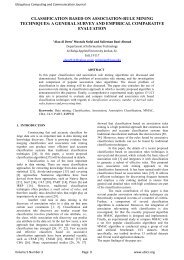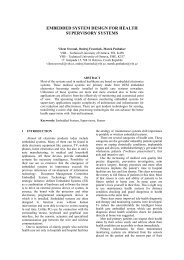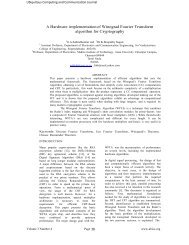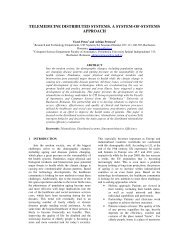Low Crest Factor Modulation Techniques for Orthogonal Frequency ...
Low Crest Factor Modulation Techniques for Orthogonal Frequency ...
Low Crest Factor Modulation Techniques for Orthogonal Frequency ...
Create successful ePaper yourself
Turn your PDF publications into a flip-book with our unique Google optimized e-Paper software.
Ubiquitous Computing and Communication Journal<br />
distributed variable having a mean of zero. And<br />
thus, the absolute value will have Rayleigh<br />
distribution.<br />
The crest factor of the discrete time representation<br />
x(k) is defined as the ratio of the peak magnitude<br />
value and the square root of the average power of<br />
this signal. For the OFDM signal as we mentioned it<br />
have a zero mean and thus the square root of the<br />
average power will be equal to the standard<br />
deviation δ. Thus the crest factor can be written as:<br />
CF = max(x(k )) = max(x(k )) (2)<br />
E ( x 2 ) δ<br />
Note that, the peak to average power ratio, widely<br />
used in literature, is simply the square of the crest<br />
factor. Both quantities coincide, if expressed in<br />
logarithmic scale (dB).<br />
An OFDM system is simulated using Matlab with<br />
512 sub-carriers; We have per<strong>for</strong>med a measure of<br />
normality, i.e., wither the composite time signal<br />
approaches the normal distribution or not, as a<br />
verification of the applicability of central limit<br />
theory to OFDM, and we get the following result as<br />
shown in figure (1)<br />
It can be noticed that the real and imaginary parts of<br />
the OFDM signal completely agree with the normal<br />
distribution.<br />
a. The minimum Euclidean distance amongst<br />
phasors, which is characteristics of the noise<br />
immunity of the scheme<br />
b. The minimum phase rotation amongst<br />
constellation points, determining the phase jitter<br />
immunity<br />
c. The peak to average phasor power, which is a<br />
measure of robustness against non-linear distortion<br />
introduced by power amplifiers.<br />
Fig.(2) Block diagram of OFDM system<br />
Probability<br />
0.999<br />
0.997<br />
0.99<br />
0.98<br />
0.95<br />
0.90<br />
0.75<br />
0.50<br />
0.25<br />
0.10<br />
0.05<br />
0.02<br />
0.01<br />
0.003<br />
0.001<br />
Normal Probability Plot<br />
The Bandwidth efficiency can be increased either by<br />
increasing the Number of signal phase levels, or by<br />
increasing the Number of signal amplitude levels<br />
[6],<br />
1. Increasing the signal amplitude levels has the<br />
drawback that the signal envelope is not constant<br />
and there<strong>for</strong>e non-linear amplification may cause<br />
spreading of the signal spectrum and increase in<br />
BER.<br />
2. Increasing the Number of phase levels will<br />
highly increase the BER.<br />
-0.5 -0.4 -0.3 -0.2 -0.1 0 0.1 0.2 0.3 0.4<br />
Data<br />
Fig.(1) Normal probability plot of OFDM signal<br />
3. OFDM USING DIFFERENT MODULATORS<br />
In this section we will simulate an OFDM system<br />
as shown in the block diagram in figure (2) using<br />
different modulation techniques.<br />
We have simulated an OFDM system with different<br />
modulation techniques, namely, M-ary PSK, M-ary<br />
QAM (with M=4, 8, 16 and 32) and Minimum Shift<br />
Keying (MSK).<br />
When designing a constellation diagram <strong>for</strong> a<br />
modulation technique, some considerations must be<br />
given to [5]:<br />
Fig.(3)OFDM Spectrum with different modulation<br />
We have noted that <strong>for</strong> M-PSK, as M increases no<br />
effect has been occurred to the dynamic range and<br />
the PAR remains nearly the same, while <strong>for</strong> M-<br />
QAM, as M increases the dynamic range increase<br />
and so the PAR, but both of them agree in the<br />
Volume 2 Number 5 Page 112 www.ubicc.org


